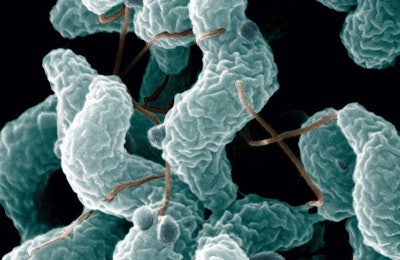
This article appears in the July issue of Poultry International. View all of the articles in the digital edition of this magazine.
There are an estimated 9 million cases of campylobacteriosis in the EU alone each year, costing EUR2.4 billion (US$2.72 million). There is still no definitive solution to control Campylobacter in poultry flocks. However, there are several strategies that can be followed to reduce its incidence, so improving food safety and enhancing farm profits.
Broiler producers need to apply a series of measures to reduce Campylobacter contamination levels, requiring a mixed approach, starting with improved biosecurity, changes to management practices, proven feed or water intervention with additives and, finally, intervention measures during slaughter.
Biosecurity
Biosecurity has already been improved in many countries over and above the standard controls, with marked increases in “barrier” biosecurity into each poultry house.
This means that each poultry house worker has footwear which can only be used in the house, and there is a physical barrier at the entrance where boots have to be changed before entering the house.
Some studies have suggested that flies can be a vector for Campylobacter, so installation of fly screens over air inlets can further enhance biosecurity. However, it is necessary to ensure that ventilation rates are maintained and screens kept clean.
Thinning
Stopping thinning has been shown to reduce the incidences of Campylobacter contamination in broilers in markets such as Scandinavia, where farms are restricted in size and “down time.”
However, in the larger poultry markets, where per capita consumption of poultry meat is greater, the difficulties in increasing the housing requirement to comply with EU or local regulations, would mean that this could only be brought in gradually, and the cost of chicken to the retailer would have to increase.
Slaughterhouse interventions
In-slaughterhouse interventions include high chlorine washes (not permitted in the EU) or extreme temperature treatments: either rapid surface chilling, or steam along with ultrasound. Both these treatments can reduce the level of contamination on the carcass by between 1 and 2 log10.
However, much will depend on the level of contamination entering the slaughterhouse as to the levels on saleable chicken.
These management methods, however, are not all applicable universally, for example within the EU there are restrictions due either to availability legislation or consumer demand for carcass size.
In addition to management strategies, there is also the option to use feed additives or water treatments, which can further reduce the level of Campylobacter contamination.
Bacteriocins
Bacteriocins have been shown in trials to have some effect in reducing Campylobacter contamination levels in the caeca, however more investigative work is required.
Bacteriophages
In vivo use tends to be therapeutic. Bacteriophages have been considered for in slaughterhouse treatment of carcasses, however, problems may arise in registration.
Organic acids
A mixture of acids is needed to control campylobacter, and the pH of drinking water must be lowered to between 4.0 and 4.5 for optimum results. To date, results using organic acids have been varied.
Phytogenic feed additives
In vitro trials using phytogenic feed additives have not, to date, been replicated in vivo and, as with bacteriosins, more work still needs to be carried out.
Probiotics
Several trials using probiotics to control Campylobacter colonization have been carried out and have shown significant reductions in bacterial colonization. Use of probiotics may be the most promising approach for controlling Campylobacter through nutritional interventions.
Multi-approach, multi-benefit
Each of the interventions listed above will help to reduce overall contamination. Combined, they may possibly give the required reduction of Campylobacter contamination in finished broiler meat.
The impact of campylobacteriosis in humans is well known. It usually results in severe abdominal pains and diarrhea, which can lead to hospitalization. But it is worth remembering that it can lead to death and, in some cases, lead to serious complications, such as Guillain-Barre syndrome, reactive arthritis, bacteremia, inflammatory bowel disease and irritable bowel syndrome.
It is also important to remember that Campylobacter spp are not necessarily commensal bacteria but have been shown to have the potential to cause disease in poultry: diarrhea and reductions in feed efficiency.
In the U.K., for example, estimates suggest that the costs to the industry are up to GBP20 (US$29.16) per 1,000 broilers. Controlling the situation on farm is of benefit to poultry producers, and not just meeting contamination levels for poultry leaving the processing plant.

USDA finalizes Salmonella, Campylobacter reduction measures















